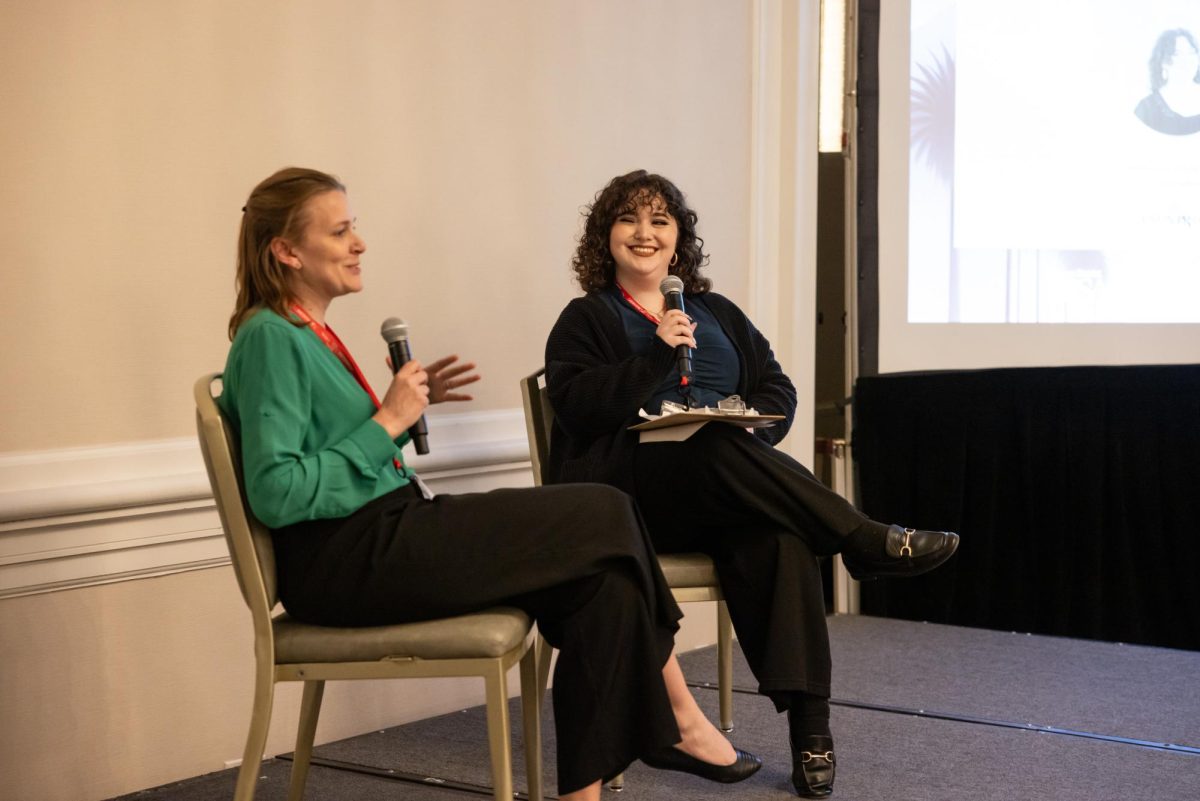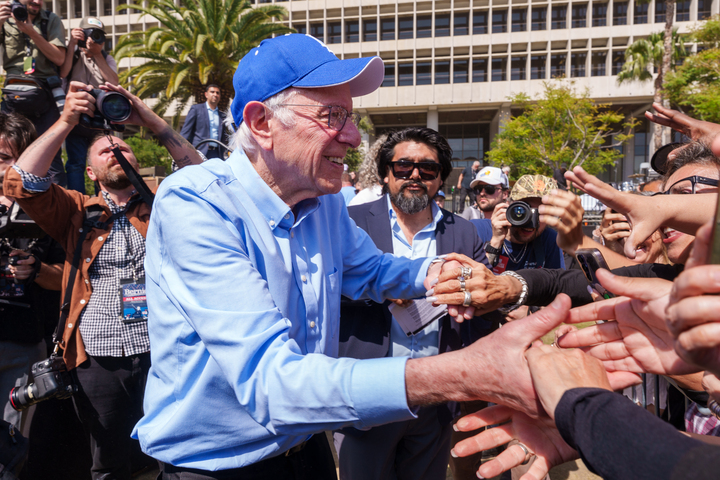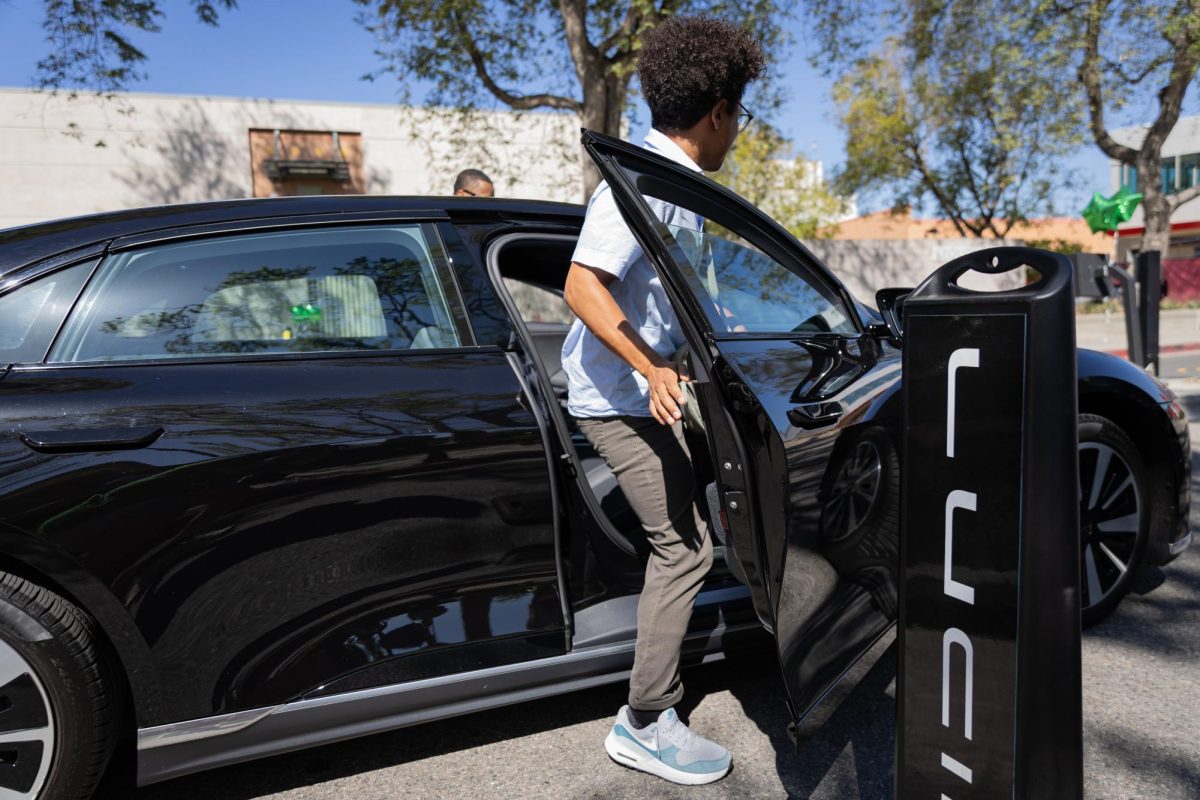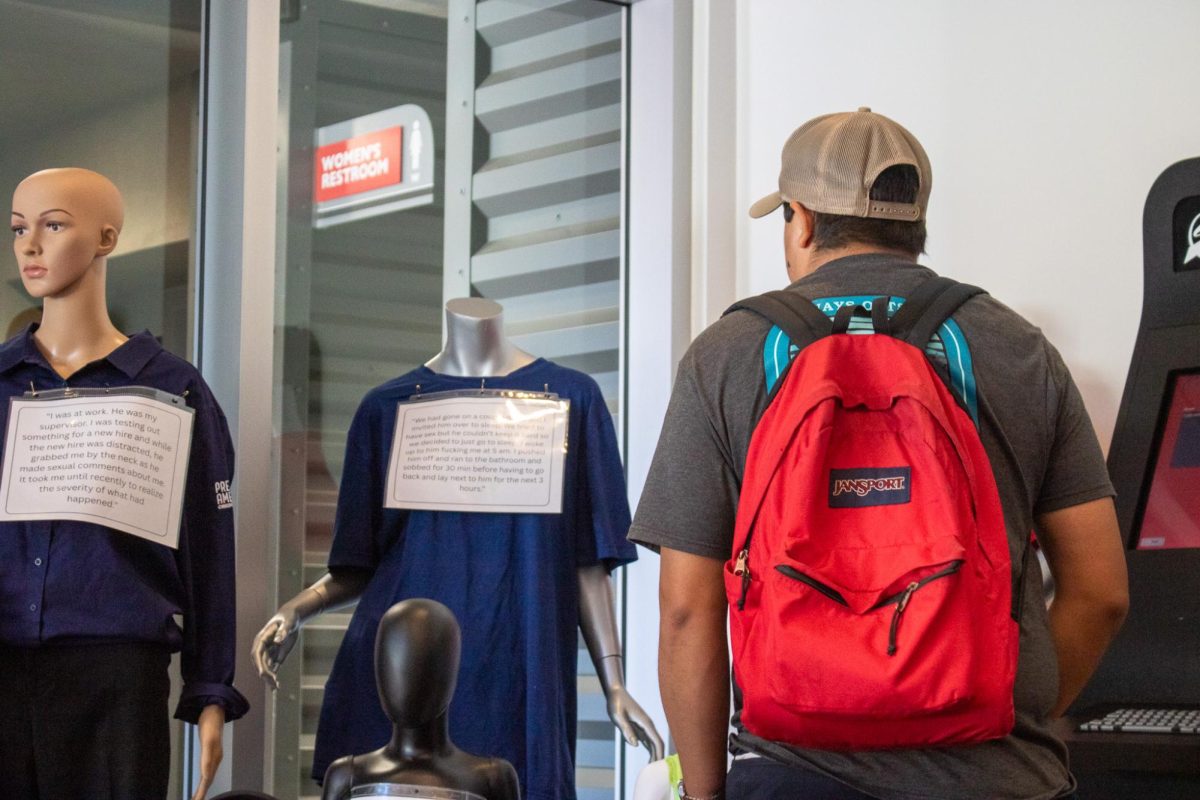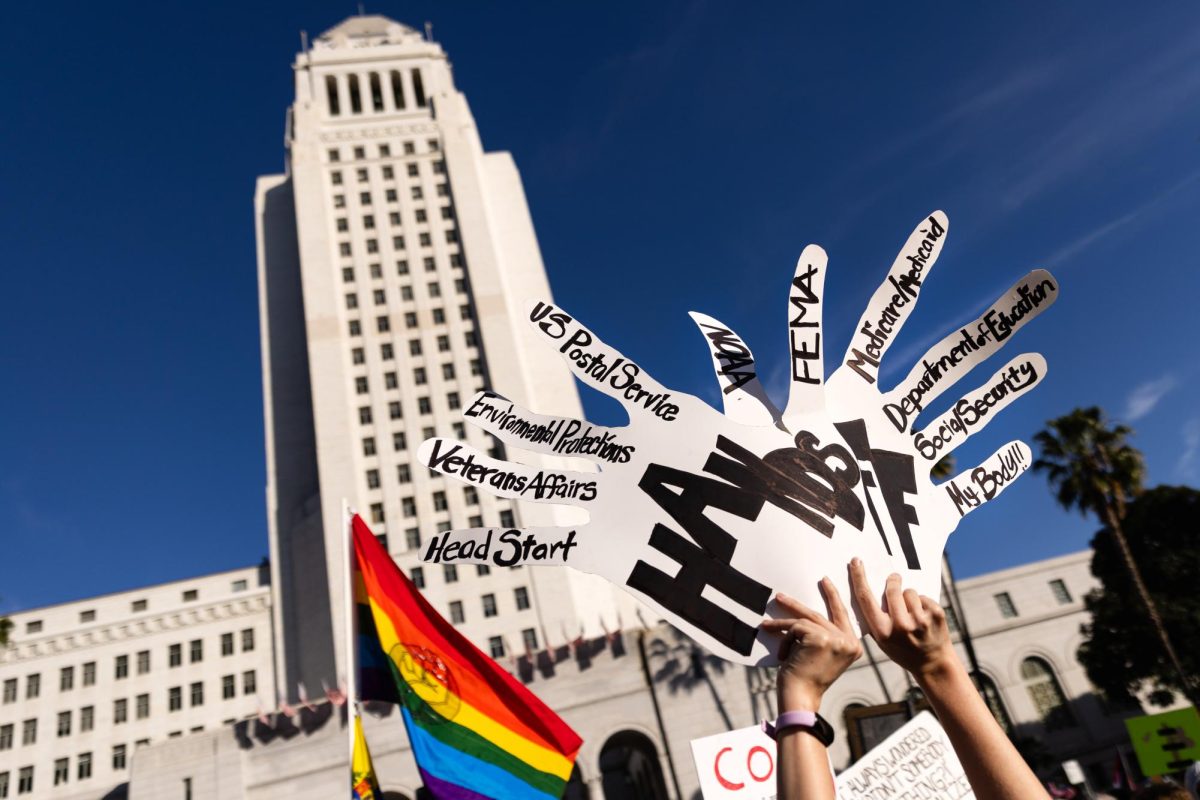
CSUN’s protest against budget cuts to California’s higher education incorporated lessons from last year’s demonstration. The idea of education as a human right drew mixed reactions from the student body in the day-long protest Wednesday.
The Oviatt Library lawn served as anchor for the protest. From 10 a.m. until about 5 p.m., students, teachers and community members participated in the action against implemented and proposed funding cuts to the CSU and UC systems.
The library was flanked on either side of its staircase with student-made banners reading, “Wake up, walk out!” The campus was also decorated with homemade signs displaying, “Quality education, not corrupt administration” and “Where have all the classes gone?”
Wednesday’s march was run by Activist Student Coalition, a student-run organization, in cooperation with other CSUN student groups including Students for Quality Education.
Students led rallies in front of the library throughout the day.
Kenya Parham, 22, political science and Pan African studies double major, was one of the students who led those demonstrations, during which she commented on the diversity of the crowd before her.
“I’m coming to you as a black female in higher education,” she said. “If we have more cuts, there will be less students that look like me and you, and that’s unfortunate.”
Parham, a graduating senior, noted that ethnic studies programs are usually the first to be cut in times of budget crisis, citing CSULA’s recent loss of their Asian and Asian American Studies department.
She said past CSUN students fought for ethnic studies programs, such as Pan African, Chicano and Central American studies to be included in the curriculum and it is the responsibility of current students to protect those achievements.
Rallying cries of “Student power!” and “Cut back – fight back!” were amplified through megaphones as students raised picket signs.
Gender and women’s studies major John Anderson, 22, wore a sandwich board and held a sign that read, “Education is my future, I’ll fight to keep it.”
Anderson, a senior, said his sign is meant to reflect his support of civil disobedience and nonviolent activism.
“Making students shoulder the deficit is not the solution to (the budget crisis),” Anderson said. “Creating a mass of uneducated people is going to create even more problems.”
Anderson, who described himself as “one of the lucky ones” who does not need to worry about paying for tuition, said every student is affected regardless of their financial situation.
“I want to see the powers that be (start to) care,” he said.
Demonstrations echoed that desire of legislative leaders to increase their awareness of students’ plight and advocated students’ responsibility to take control of their education.
Associated Students Senator Amanda Flavin told students they have more resources than they are aware of.
“You cannot call yourself educated if you do not know about the bodies that make policies that affect you,” said the business and economics senator.
Flavin referred the crowd to visit www.legisweb.com to educate itself on state budget policy and to contact the student representative that serves on the CSU Board of Trustees.
Students couldn’t help but compare the event to last year’s demonstration. Passers-by commented that Wednesday’s protest was not as large or vibrant as the year before.
Senior Jonnae Thompson, 23, one of the five demonstrators arrested at last year’s protest, recognized the loss of momentum and wasted energy after last year’s event ended.
“There’s too much power in here right now,” said the senior English major. “I can’t watch (last year’s) March 4 happen again.”
She invited students to return to the library steps at 7 p.m. to debrief on the day’s activities and brainstorm possible solutions. At that gathering, students discussed the role of social media and encouraged each other to get involved on campus.
Protestors cited specific legislation that may help or hinder the CSU system.
Assembly Bill 900, the prison construction and rehabilitation initiative signed by former Gov. Arnold Schwarzenegger in 2007, was mentioned.
According to a policy brief from the Legislative Analyst’s Office (LAO), the project costs $7.7 billion and would create 1.76 million square feet of correctional facilities between 2011 and 2013.
Loyola Marymount University sophomore Lucie Sutton held signs designed by her mother for non-profit organization Californians United for a Responsible Budget (CURB).
“California is number one in prison spending and very low in education spending,” Sutton, 19, said. “There aren’t even enough prisoners to fill all the space they’re creating.”
Sutton, who joined CSUN’s protest because of her mother’s involvement and her best friend attends the university, said there is a direct correlation between the potential for more prisoners and less funding given to higher education.
“Kids are on the street when they could be in class,” she said.
Other legislation cited was AB 656, which would direct revenue from oil and gas services taxes to higher education in California, and Gov. Jerry Brown’s 2011-2012 budget, proposed to cut at least $500 million from the state university system pending voter approval.
The rally’s rhetoric became confused at times with student leaders claiming Brown “cut one billion dollars” from the university system. To clarify, if voters do not approve of tax extensions, the $500 million cut could double to one billion dollars diverted from California higher education.
Fliers dispersed by Students for Quality Education also noted their opposition of lucrative salaries earned by CSUN President Jolene Koester and CSU Chancellor Charles Reed, claiming they are inappropriate considering students’ increasing financial burden and loss of classes. The flier, produced by California Faculty Association, reported that Reed would earn approximately $451,500 in 2011.
While some students noted the irony of walking out on expensive, scarce classes to demand more education, the message of the rally seemed to stay consistently on education.
Professor Jeanine Minge held her upper division communications class outside on the Oviatt Lawn next to the demonstrators. Minge’s performance and social change class studied the performance of activism.
Senior Lauren Keating, 22, communications major, said in addition to their outdoor lecture, the class exhibited art. Twenty-five folding chairs were laid on the ground surrounding one empty, upright folding chair.
“This demonstration recognizes that students cannot add classes, they cannot afford to stay in school,” she said. “Being outside, we are also representing the loss of classroom.”
Toward the end of the rallies, civil rights activist and guest lecturer Rev. James Lawson addressed the crowd. He commended the students for their participation and told them to ignore propaganda that tells them they are powerless.
“It is the role of the government, society and institutions to serve the next generation and allow them to achieve their fullest potential,” Lawson said. “School is meant to educate its students for the multiplicity of roles they will play.”
Lawson offered a solution to national budget crisis: end the wars in the Iraq and Afghanistan. He said hundreds of billions of dollars could be brought back to the U.S. to be used to educate people.
“But it’s not about money,” Lawson said. “It’s about the courage and character of those in power to put first things first.”
In juxtaposition to the cries of students claiming lack of finances, CSUN held its outdoor bazaar on the Matador Walk next to the library, inviting those same students to purchase a variety of wares from jewelry to cell phone accessories to vacation packages.
The Matador Mall, held every semester, was quiet while students moved their march around campus but some shoppers remained.
Freshman Violet Carlsberg, 19, economics major, perused posters with a friend but said she did not plan on protesting.
“I didn’t know what it was about. I’d need to know more about both sides,” she said. “They seem to be taking it seriously but there needs to be more participation.”
Nabil Nassery, proprietor of the cell phone accessory tent, said participation has driven away business from the popular vendor.
“I feel like I’m here for nothing,” Nassery said. “I’m losing 75 percent of business today that I had yesterday.”
The skepticism expressed by Carlsberg was not lacking on CSUN’s campus, despite the throngs of students vocalizing their concerns.
Senior Lily Oliveros, 23, a transfer student, said the low turnout probably would not be effective in calling attention to students’ problems.
“It could’ve been more publicized, a lot of people were unaware,” she said. “I just found out in class Tuesday.”

